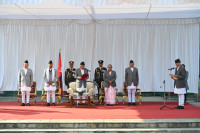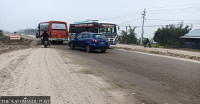National
Domestic airfares hit rock bottom amidst coronavirus travel advisory
Customers might be benefiting from low prices but airlines are looking at hard times—even considering layoffs.
Sangam Prasain
The price of a domestic airline ticket has hit a record low, having consistently fallen over the past two weeks amidst the government’s travel advisory triggered by the Covid-19 outbreak.
Domestic air passengers are laughing all the way to the airport, but the burgeoning domestic airline industry is now battling for survival.
For instance, the normal one-way airfare on a Kathmandu-Bhadrapur flight is Rs9,100, but on Tuesday, travellers were able to buy a ticket for as low as Rs2,800.
Similarly, the lowest airfare for Kathmandu-Dhangadhi, the country’s longest domestic route, was available at Rs4,400, against the normal one-way airfare of Rs12,650. The airfare on Kathmandu-Janakpur was priced at Rs2,200 on Tuesday, down from Rs4,300.
“It’s a historic low in terms of real value,” said Birendra Bahadur Basnet, managing director of Buddha Air, Nepal’s largest private airline in terms of passenger carriage.
Real value is the relative price after it has been adjusted for inflation.
Basnet said that people are not travelling due to the coronavirus scare but that the market is also overwhelmed by competition.
“Based on the current trend, airfares may drop further,” he said, surmising that the existing environment could put operators at a risk of collapse leading to only the strongest players surviving.
But there is a silver lining. The price of crude oil has also suffered a historic collapse on Monday and the industry is eagerly watching the actions of the government in protecting the industry.
Brent crude, the global benchmark, plunged 24 percent to close at $33.36 a barrel on Monday.
“The industry is obviously cheering the fall, but it depends on how the government handles this situation,” said Basnet. “If oil prices are adjusted in line with the international market, the airlines can break-even. Otherwise, the collapse of some airlines is imminent.”
Peak-season fares, which plunged to the lowest this month, have been attributed to three major factors—low foreign tourist movement, who usually pay in dollars and for whom airfare is twice or thrice as high as that for Nepalis, during peak tourist season; the government’s advisory that asks that meetings, seminars and conferences not be held; and intensifying competition among airlines to fill up seats by slashing prices to order to avoid flying empty.
March marks the beginning of the spring tourist season, leading to a travel spurt mainly in trekking and expeditions—in particular, the high-end Everest season —which encourages airlines to charge dollar fares. Kathmandu-Lukla airfare is $180 for foreigners, which is used by domestic airlines to subsidise airfare for domestic passengers.
If the situation prolongs, the extent of the damage to the domestic airlines could be significant, airline operators said. In order to offset losses, airlines are preparing for layoffs, according to industry insiders.
A number of key airlines that the Post spoke to said they were offering tickets at one-third of the normal fare due to overheated competition among carriers to attract passengers in the face of low movement.
“Stiff competition has upended traditional business practices, with the airline industry selling domestic tickets at the cheapest rates,” said Anil Manandhar, corporate manager of Shree Airlines.
The Rs2,800 one-way air ticket between Kathmandu and Bhadrapur is the same as that of travelling by microbus, said Manandhar.
“In the trunk route sector, where foreign tourist movement is lower, airlines are suffering from reduced movement of young Nepalis coming to Kathmandu for the international labour market,” he said.
There have been restrictions on travel to a number of foreign employment destinations, either by the Nepal government or the receiving government, due to fears of the spread of Covid-19.
Competition escalated after Shree Airlines entered the domestic sector in August 2017 with a number of jet aircraft, shocking existing carriers with rock bottom fares. Domestic airlines then began to add 70-plus-seat aircraft to their fleets as they foresaw an increased demand for travel. More than a dozen 70-seat aircraft have been added in the last two years due to a rapid rise in the number of air travellers.
Tribhuvan International Airport statistics show that domestic passenger traffic increased by a solid 11.96 percent to 3.18 million last year. This translates to an average of 8,735 persons travelling by air daily. A decade ago, there were 1.37 million air travellers in the domestic sector. Domestic airlines dangled cheap tickets to attract 340,727 new passengers last year.
But the risk to a once vibrant industry is now looking real.
“This is the season [March-May] for domestic airlines to compensate for losses incurred during the lean travel season,” said Rameshwor Thapa, president of the Airlines Operators Association of Nepal, the umbrella body of private airline operators in Nepal. “Losses may balloon if the current situation prevails.”
In a domestic market estimated at around Rs14 billion, the industry has already lost Rs4 billion.
Last week, the association issued a statement saying that in the first two months of this year, foreign tourist occupancy in the domestic airlines had dropped by 40 percent.
The association has asked the government to launch bailout packages like refinancing, waiver of VAT imposed on aviation fuel, reduce fuel prices by 30 percent, and provide free landing, parking and navigation charges for all of 2020. If things don’t improve, the association has warned that it will be forced to lay off employees.
According to Basnet, offering low fares may encourage domestic tourism, which could bail out the hospitality and airlines industry, but then again, as the government has discouraged non-essential travel due to the coronavirus scare, that plan is likely to remain grounded.




 17.12°C Kathmandu
17.12°C Kathmandu















